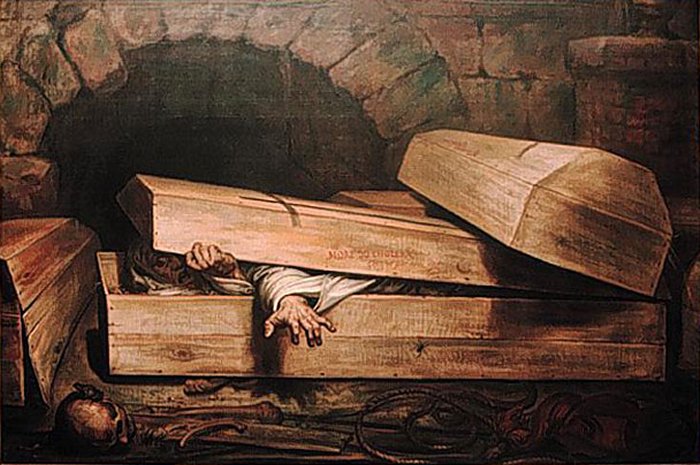Strange History Of Safety Coffins: From Ancient To Modern Times
A. Sutherland - AncientPages.com - The fear of being buried alive has been a constant companion of humankind for as long as anyone can remember. As bizarre as it might sound, certain variations of safety coffins designed during the 18th and 19th centuries are still in practice today.
The recovery of supposedly dead victims of cholera, as depicted in The Premature Burial by Antoine Wiertz, fuelled the demand for safety coffins. Image credit: Antoine Wiertz - source - Public Domain
Taphophobia is the medical term for fear of being buried alive due to being incorrectly pronounced dead.
Taphophobia can be justified due to the number of cases of people being buried alive by accident. In 1905, the English reformer William Tebb collected accounts of premature burial. He found 219 cases of near-live burial, 149 actual live burials, 10 cases of live dissection, and 2 cases of awakening while embalmed. Of course, Edgar Allan Poe's novel The Premature Burial, published in 1844, resulted in even greater fear, mainly since the book contained accounts of supposedly genuine cases of premature burial.
Therefore, it's not a surprise people feared coffins and graves.
During the 18th and 19th centuries, many safety coffins were patented. Many sarcophagi were fitted with a mechanism to allow the occupant to signal that they had been buried alive.
The first recorded safety coffin was constructed on the orders of Duke Ferdinand of Brunswick before he died in 1792. The Duke demanded to have a window installed to allow light in and an air tube to supply fresh air, and instead of having the lid nailed down, he had a lock fitted. In a unique pocket of his shroud, he had two keys, one for the coffin lid and a second for the tomb door.
The trouble with many designed safety coffins was that they included ladders, escape hatches, and even feeding tubes, but their creators forgot to implement a method for providing air.
In 1798, P.G. Pessler, a German priest, suggested that all coffins must have a tube inserted from which a cord would run to the church bells. If an individual had been buried alive, he could draw attention to himself by ringing the bells.
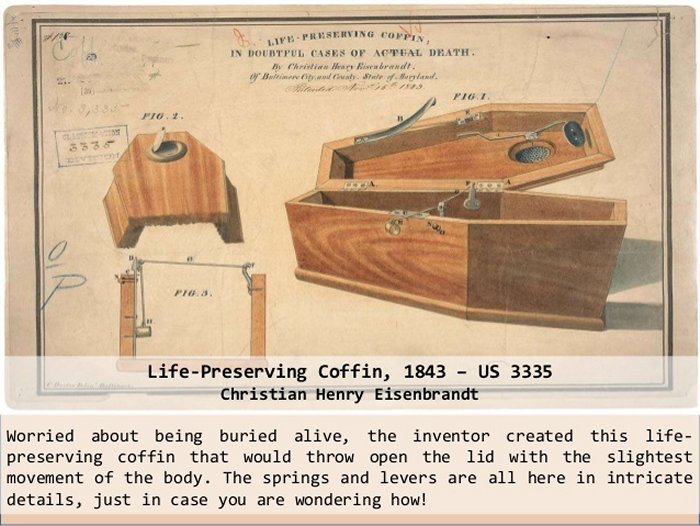
Pessler's colleague, Pastor Beck, suggested that coffins should have a small trumpet-like tube attached. Each day, the local priest could check the state of putrefaction of the corpse by sniffing the odors emanating from the box. If no smell was detected or the priest heard cries for help, the coffin could be dug up and the occupant rescued.
In 1822, Dr. Adolf Gutsmuth wanted to demonstrate his ingenious safety coffins. He was buried alive, stayed underground for several hours, and even ate a meal delivered to him through the coffin's feeding tube.
Improvement of safety coffins and their mechanism continued. In 1829, Dr. Johann Gottfried Taberger designed a system using a bell that would alert the cemetery night watchman.
In 1900, Walter McKnight of Buffalo, NY, patented an all-electric device for "indicating the awakening of persons buried alive." In addition to the usual air pipe to the surface, a giant electromagnet (solenoid) pulled up a cap on the air pipe when the movement of the corpse's hands closed a switch. An electric bell was mounted outside the enclosure.
A telegraphic grave signal device was patented in 1901 by Monroe Griffith of Sioux Falls, IA. In addition to the wiring of hands and feet to signal awakening and movement of the corpse switches under the corpse would close if grave robbers lifted the body. Rather than a buzzer above the grave, the wires lead to a central office such as "the home of the cemetery sexton or police station."
In 1908, George Willems of Roanoke, IL, patented a grave attachment that consisted of a pipe at the foot of the coffin leading to the surface, with an adjustable mirror at each end and a remote-controlled flashlight. The idea was to observe the corpse for several days after burial.
1913 brought a more sophisticated device for detecting a corpse "in hospitals, morgues, crematories, at bathing beaches and on ocean-going steamers." Peter Backus, of Delphos, OH, was the inventor. The elaborate apparatus consisted of a motor-driven vacuum pump, electric heaters, a telephone monitor, and a unique stretcher in a sealed casket. Presumably, a professional operated this apparatus and performed tests for residual life in the corpse.
As late as 1983, Fernand Gauchard of France patented a coffin life detector. The device used electrical relays and included a vacuum pump but still relied on the old standby of detecting body movement to trigger the alarm.
In 1995, a modern safety coffin was patented by Fabrizio Caselli. His design included an emergency alarm, an intercom system, a torch (flashlight), a breathing apparatus, a heart monitor, and a stimulator.
It is believed that the phrases "saved by the bell," "dead ringer," and "graveyard shift" come from the use of safety coffins in the Victorian era.
The fear of being buried alive is still with us today. However, it is interesting to note that no documented cases of anybody being saved by a safety coffin.
Written by - A. Sutherland - AncientPages.com Senior Staff Writer
Updated on October 29, 2023
Copyright © AncientPages.com All rights reserved. This material may not be published, broadcast, rewritten or redistributed in whole or part without the express written permission of AncientPages.com
Expand for referencesMore From Ancient Pages
-
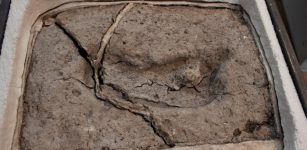 Discovery Of Oldest Human Footprint In The Americas Can Re-Write History
Archaeology | Apr 30, 2019
Discovery Of Oldest Human Footprint In The Americas Can Re-Write History
Archaeology | Apr 30, 2019 -
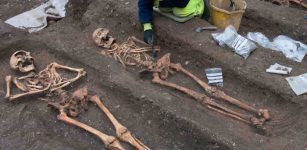 Medieval Friars Were ‘Riddled With Parasites,’ Study Finds
Archaeology | Aug 19, 2022
Medieval Friars Were ‘Riddled With Parasites,’ Study Finds
Archaeology | Aug 19, 2022 -
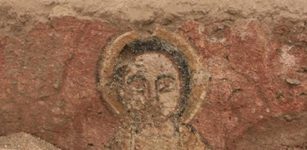 1,000-Year-Old Paintings Unearthed In Sudan – Documented By The Polish Researcher
Archaeology | Sep 25, 2022
1,000-Year-Old Paintings Unearthed In Sudan – Documented By The Polish Researcher
Archaeology | Sep 25, 2022 -
 Pharaoh Ay – A Man With A Hidden Agenda Or A Victim Of Unfortunate Circumstances?
Featured Stories | Feb 5, 2019
Pharaoh Ay – A Man With A Hidden Agenda Or A Victim Of Unfortunate Circumstances?
Featured Stories | Feb 5, 2019 -
 Ancient Pathogens Released From Melting Ice Could Wreak Havoc On The World – New Analysis Reveals
Featured Stories | Aug 2, 2023
Ancient Pathogens Released From Melting Ice Could Wreak Havoc On The World – New Analysis Reveals
Featured Stories | Aug 2, 2023 -
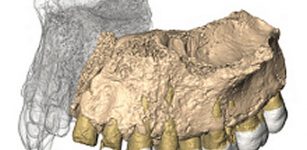 Earliest Modern Human Fossil Outside Africa Unearthed At Misliya Cave, Israel
Archaeology | Jan 27, 2018
Earliest Modern Human Fossil Outside Africa Unearthed At Misliya Cave, Israel
Archaeology | Jan 27, 2018 -
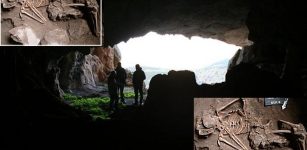 Ancient Genomes Suggest Farming In Africa Was Ignited By Oversea-Migrants From Iberia 7,400 Years Ago
Archaeology | Jun 7, 2023
Ancient Genomes Suggest Farming In Africa Was Ignited By Oversea-Migrants From Iberia 7,400 Years Ago
Archaeology | Jun 7, 2023 -
 Cooking, Roasting And Eating Of Root Plants Is 120,000-Year-Old Habit
Archaeology | Jun 7, 2019
Cooking, Roasting And Eating Of Root Plants Is 120,000-Year-Old Habit
Archaeology | Jun 7, 2019 -
 Why Were Egyptian Pyramids Built Along Long-Lost Ahramat Branch Of The Nile?
Archaeology | May 16, 2024
Why Were Egyptian Pyramids Built Along Long-Lost Ahramat Branch Of The Nile?
Archaeology | May 16, 2024 -
 Long-Lost Tomb Of Pharaoh Thutmose II Finally Found In Luxor, Egypt
Archaeology | Feb 19, 2025
Long-Lost Tomb Of Pharaoh Thutmose II Finally Found In Luxor, Egypt
Archaeology | Feb 19, 2025 -
 Secret Underground Ancient Teotihuacan Tunnel May Solve A Long-Standing Mystery And Reveal Royal Tombs
Civilizations | Jul 8, 2016
Secret Underground Ancient Teotihuacan Tunnel May Solve A Long-Standing Mystery And Reveal Royal Tombs
Civilizations | Jul 8, 2016 -
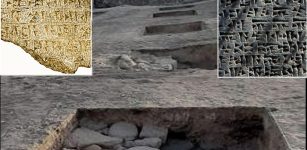 Monumental Structure Unearthed During Excavations Of Urartu-Era Karmir Blur
Archaeology | Nov 25, 2022
Monumental Structure Unearthed During Excavations Of Urartu-Era Karmir Blur
Archaeology | Nov 25, 2022 -
 Research Reveals A 3,500-Year History Of Dairy Consumption On The Tibetan Plateau
Archaeology | Apr 17, 2023
Research Reveals A 3,500-Year History Of Dairy Consumption On The Tibetan Plateau
Archaeology | Apr 17, 2023 -
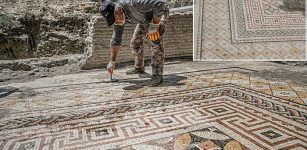 Yet Another Beautiful Roman Mosaic In Hatay, Turkey
Archaeology | Jul 14, 2022
Yet Another Beautiful Roman Mosaic In Hatay, Turkey
Archaeology | Jul 14, 2022 -
 New Details On Neanderthals – Revealed By Museum Exhibition In Norway
Archaeology | Jun 16, 2023
New Details On Neanderthals – Revealed By Museum Exhibition In Norway
Archaeology | Jun 16, 2023 -
 Secrets Of The Freemasons – Masonic Symbols Reveal Worship Of Ancient Mother Goddesses
Ancient Symbols | Jun 18, 2018
Secrets Of The Freemasons – Masonic Symbols Reveal Worship Of Ancient Mother Goddesses
Ancient Symbols | Jun 18, 2018 -
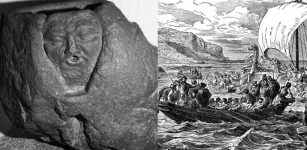 Ancient Mysteries Of Chicago: Is The Puzzling Waubansee Stone A Neglected Pre-Columbian Artifact?
Artifacts | Mar 4, 2017
Ancient Mysteries Of Chicago: Is The Puzzling Waubansee Stone A Neglected Pre-Columbian Artifact?
Artifacts | Mar 4, 2017 -
 Ancient History Of Chinese Swords
Featured Stories | Aug 20, 2018
Ancient History Of Chinese Swords
Featured Stories | Aug 20, 2018 -
 Anglo-Saxon Harpole Treasure Reveals More Secrets – Unique Medieval Silver Cross Found
Archaeology | Jan 31, 2023
Anglo-Saxon Harpole Treasure Reveals More Secrets – Unique Medieval Silver Cross Found
Archaeology | Jan 31, 2023 -
 Ancient Mystery Of The Enigmatic ‘Cat Men’ – The Arrival – Part 1
Ancient Mysteries | Jan 17, 2021
Ancient Mystery Of The Enigmatic ‘Cat Men’ – The Arrival – Part 1
Ancient Mysteries | Jan 17, 2021

